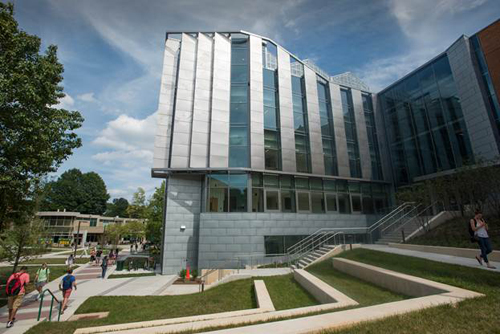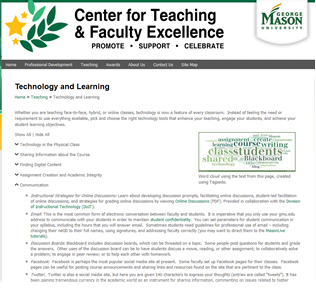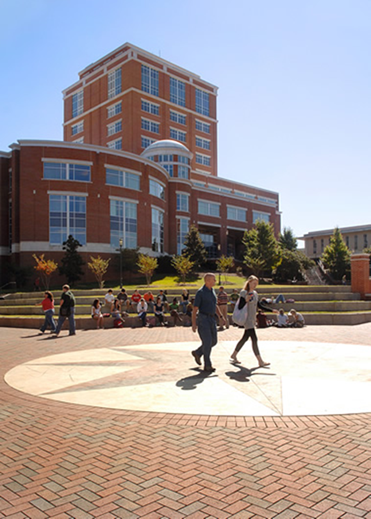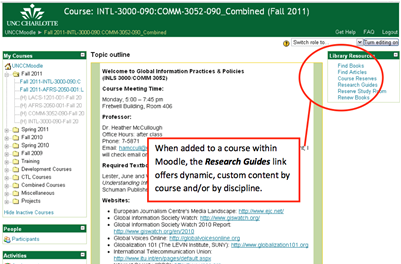Key Takeaways
- Staff members at two universities — the University of North Carolina at Charlotte and George Mason University — sought to investigate how librarians, academic technologists, learning technologists, and academic departments might collaborate across institutions and create new opportunities for teaching, learning, and research support.
- Library and technology professionals are uniquely positioned to work together to help faculty develop and deliver rich learning materials; their collaboration enables innovation at a level often impossible in these economically uncertain times.
- An example of this collaboration is the development of a library resources module embedded into one institution's Moodle homepage that both gives students direct access to materials and raises the library's profile.
Despite uncertain times and the steady decline in state funding for colleges and universities, institutions find a constant need for innovation in teaching and learning. Supporting this innovation can be both exciting and challenging for university libraries and instructional technology organizations at large public institutions. In this article, we share some of the challenges in this innovation support and offer ideas for making a little collaboration go a long way.
Challenges to Supporting Innovation
As large, urban research-intensive public institutions, the University of North Carolina at Charlotte and George Mason University share many similar challenges in supporting teaching, learning, and research with technology. In particular, both institutions face diminished funding, dynamic growth in enrollments, unique institutional culture and expectations, and large scale. Here, we describe how our library and instructional technology units approach innovation to create common ground for collaborating, with an emphasis on specific strategies.
UNC Charlotte
UNC Charlotte is a dynamic, urban research institution that has seen strong enrollment growth while also building its identity as a research-intensive university. For almost 15 years, enrollment figures have consistently grown each year. In fall 2012, more than 3,500 new freshmen enrolled, and total official enrollment surpassed 26,000.1 In addition, the university has added graduate programs and research centers and currently has more than 80 master's and doctoral programs. Its legacy of valuing the teaching mission and providing excellent teaching continues to be a core value as well.
Budgetary challenges — which most institutions face these days — coupled with rapid institutional growth have posed challenges. In particular, rapid growth and a funding model that leans on year-end monies for one-time purchases can encourage short-term thinking and planning and discourage cross-departmental planning. It is understandable, then, that any department's focus would narrow to its current set of services and, perhaps more limiting, that the focus of its partners narrows to include solely faculty and students.
Librarians at UNC Charlotte are experts at navigating new information flows and connecting researchers and students with knowledge. As information professionals, dedicated educators, and academics themselves, librarians are uniquely positioned to help advance intellectual discovery. However, traditional expectations about libraries and librarians can limit their contribution to moving an institution forward.
George Mason University
George Mason University has a culture of innovation. In fact, during a recent campus-wide visioning process, "Innovative" was identified as a core value of the institution. Supporters of innovation — including instructional designers, instructional technologists, learning management experts, and trainers — live for opportunities to participate in the process of creating new tools or pedagogies and to reconsider traditional approaches to education. However, when talking about teaching and learning innovation, several conflicts inevitably arise. These include funding, scalability, and return on investment (ROI) as a driver for supporting innovative projects and initiatives.
As with other public colleges and universities, state funding at Mason has been in steady decline over the past several years, leaving the university to tighten its budgets, find efficiencies, and eliminate redundancy. In such climates, it is difficult to leverage resources specifically dedicated to creating new pedagogies, instructional theories, and tools. Further, when you can develop a product worthwhile to a subset of faculty, you face two related challenges: whether or not it is scalable and whether or not there is an ROI that could support this type of innovation on a larger scale.
Shared Problems — and Possibilities
Many campuses continue to operate in silos, and the benefits of innovative efforts are often limited to individual departments or disciplines. While other factors can certainly influence an organization's ability to support innovation, the issue of funding and ROI are common to institutions across the world. This raises an interesting question: Is there a way that we can support innovation, ideas, and initiatives that encourage using new thinking, take collaboration to a new level, and can change how teaching and learning happens in the current financial environment?

Seeking Out Opportunities to Collaborate and Share Resources
We sought to answer this question by focusing on opportunities for instructional technologists and librarians to work together to support teaching and learning. At both UNC Charlotte and George Mason, our librarians, instructional designers, and technologists are dedicated and committed professionals. We need to provide pathways for them to work together consistently and ensure that they can collaborate on large-scale projects, including large course design and planning and implementation of learning management system (LMS) enhancements. This coordination will save time and steps for faculty members planning their courses, and could result in increased efficiencies through coordination and resource sharing.
Librarians, instructional designers, and instructional technologists are uniquely positioned to work together to help faculty develop and deliver rich learning materials:
- Librarians have deep knowledge in specific subject areas, as well as a keen understanding of information needs and research practices.
- Instructional technologists have expertise in the design of instruction using technology; they are also are aware of the latest tools available on campus.
- Instructional designers help the university evaluate and integrate new teaching models.
Further, both librarians and instructional technologists have expertise in teaching, pedagogy, and technology, and work hand-in-hand with faculty — and often with students — on a daily basis.

Students can take a very active role in the partnership between these professionals and faculty members or academic departments. In fact, George Mason University's Division of Instructional Technology leverages its student workforce in many areas to provide frontline support to faculty. Typically, such employees are students in our own programs. These students staff the Collaborative Learning Hub (CLUB) and are well versed in the instructional technologies offered to the university's faculty. CLUB lab assistants can be found working side by side with faculty members, answering their LMS questions as well as helping them make their courses more interactive. Similarly, student mentors in the Student Technology Assistance and Resource Lab (STAR) are experts in the facility's high-end video and multimedia applications and work with faculty and fellow students to design multimedia projects. These students, who also mentor patrons of our Game Design Lab, are heavily recruited from the university's College of Visual and Performing Arts. In addition to helping the faculty, these student assistants gather valuable experience that translates into marketable real-world skills.
Building Partnerships for Teaching Excellence
As part of its shared commitment to working with faculty to support their teaching and learning, George Mason University's Division of Instructional Technology and Center for Teaching and Faculty Excellence (CTFE; see figure 1) are working together to provide faculty with resources for effective teaching.

Technology and Learning homepage
Instead of maintaining a separate web presence for tools and resources, the Division of Instructional Technology took advantage of CTFE's existing website — which received an average of 2,800 visits monthly during the 2012-2013 academic year — and collaborated with CTFE to include instructional technology resources and best practices on its site. As a result, faculty can access a repository of various teaching and learning with technology resources in a convenient and familiar location.
At UNC Charlotte, librarians from the J. Murrey Atkins Library successfully collaborated with instructional technologists at the UNC Charlotte Center for Teaching and Learning to provide another example of how working across departmental boundaries can foster innovation. In this case, instructional technologists and librarians partnered to develop a module for our Moodle LMS, which dynamically pulls customized library resources into course sites. Librarians recognized that Moodle's almost 90 percent adoption rate by courses presented an opportunity to connect students to high-quality, discipline-specific resources at a much higher rate than was possible through the library's website and individualized face-to-face instruction alone. Librarians and instructional technologists from the Center for Teaching and Learning together created a reusable learning object, or module, that links to customized research guides by subject, course, and section. The Center for Teaching and Learning promoted the use of this module through its website, training materials, and prominent display of the module on the main page of Moodle.2

J. Murrey Atkins Library, University of North Carolina Charlotte
In spring 2011, a group of librarians partnered with instructional technologists to develop this resource. The block that they developed is available on Moodle's main page, so every student and faculty member can see it and use it when they log in (see figure 2). This block is placed in a prime, highly visible location at the top right of the screen.

(upper right)
This project resulted in the creation of a block of library resources that is available on the main Moodle site for every student and instructor at our university; we also created a more customized block that instructors can add to their courses in Moodle (see figure 3).

The project team chose to include two types of resources in the library block:
- Resources to facilitate finding and using information for research, including links to Search for Books, Search for Articles, Course Reserves, Renew Books, and a link to a dynamic set of resources for a specific course or subject.
- A resource to facilitate students' use of the library as a collaborative study space by offering a link to reserve a Library Group Study Room, a very popular library service.
This successful project has "embedded" the library in Moodle and therefore increased the visibility and integration of library resources and services into many more courses than ever before, with great potential for further growth.
Associate Professor Concepcion Godev explains student use of the Moodle space library block (40 seconds).
Concepcion Godev, associate professor of Spanish, states that students in her graduate Spanish course, History of the Spanish Language, "like the direct access to the library from the class Moodle space library block as they have to get into Moodle to access all the class information, from instructions to daily plan and homework as well as articles that supplement the textbook."
We believe that there is further potential for fruitful collaborations between instructional technologists and librarians in the use of enterprise-level content management and learning systems, including learning management systems, institutional repositories, and e-portfolio tools. For example, many universities have institutional repositories that offer opportunities for students to organize and publish their work. 3 Librarians and instructional technologists can help connect the LMS to the institutional repository, providing a means for a final course paper or project to be published. Thus, students would be able to add their work to their own portfolios as well as participate in the process of scholarly communication.
We recommend that libraries and centers for teaching excellence develop processes that facilitate regular communication between their staffs. Participating in regular information sharing meetings between the staffs and including representation from each staff on major project planning committees — especially those involving enterprise level information systems — are two possible ways to encourage innovation and resource sharing.
Associate Provost Kim Eby discusses collaboration efforts between the Center for Teaching and Faculty Excellence and Learning Support Services (27 seconds).
As an example, at George Mason, the Center for Teaching and Faculty Excellence staff and the Division of Instructional Technology's Learning Support Services team meets each semester to talk about current and upcoming efforts in their areas. They also compare notes on the types of questions that faculty have in an effort to keep a pulse on faculty needs and concerns.
"The collaboration with our colleagues in Learning Support Services is essential to providing seamless professional development resources to faculty and graduate students who have instructional roles. At the CTFE, we are intentional about ensuring that all of our teaching and learning resources, including those that support teaching with technology, are integrated into our signature events and professional development support, such as new faculty orientation, our annual Innovations in Teaching and Learning conference, and our website," says Kim Eby, associate provost for Faculty Development and Director of the Center for Teaching and Faculty Excellence at George Mason University.
Conclusion
The examples in this article illustrate a few of the tremendous opportunities to enhance and strengthen teaching, learning, and research support that are made possible by collaborative efforts of librarians, academic technologists, learning technologists, and academic departments. These conversations must be purposefully guided and facilitated to overcome invisible silos and ingrained institutional culture.
We encourage you to step outside your comfort zone and invite a colleague for a cup of coffee to talk about the top three issues in your area or swap staff members to attend each other's meetings a few times a year. Valuable resources at your institution are just a phone call away.
- Office of Institutional Research, "Fall 2012 Official Enrollment," University of North Carolina, Charlotte, 2012.
- Leslie Adebonojo, Kathy Campbell, Joyce Nicole Harris, Somaly Kim Wu, and Lisa Nickel, "Use the Tools: How Two Libraries Used Their Course Management System to Provide Point-of-Need Service to Students," EDUCAUSE Southeast Regional Conference, 2012; and Somaly Kim Wu and Joyce Nicole Harris, "Building a Bridge One Moodle Block at a Time: Collaborating to Embed Library Resources into the Learning Management System," [http://guides.library.uncc.edu/content.php?pid=332764] J. Murrey Atkins Library (May 8, 2012).
- The value to the teaching mission is not a new idea and continues to attract attention. See, for example, Alan McCord, "Institutional Repositories: Enhancing Teaching, Learning, and Research," EDUCAUSE Library: EDUCAUSE Committee on Evolving Technologies, 2003; and David Evans and Marlee Givens, "Using Repositories in Undergraduate Teaching and Learning," EDUCAUSE Southeast Regional Conference, 2013.
© 2013 Heather McCullough and Joy Taylor. The text of this EDUCAUSE Review Online article is licensed under the Creative Commons Attribution 3.0 license.
